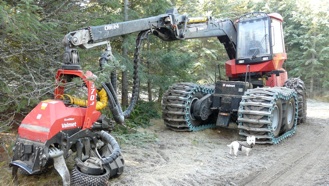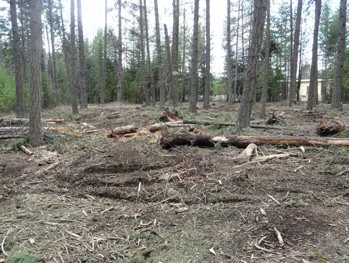

Logging The Park: State Code and Guidelines Violations
work in progress . . .
Idaho Park Board of Directors Manual
DEV. 6:92 PROTECTION OF STATE PARK LANDS – Lands acquired for state parks should remain dedicated to that use and protected against exploitation contrary to that purpose, as specified in the Idaho Code, policies of the Board, and approved master plans. Uses not in conformance with the master plan should be considered only when no other reasonable means of accomplishing the purposes of that use are available and where there will be no destruction of park values.

Idaho Code: OPE. 5:73, 08
FOREST MANAGEMENT POLICY ON STATE PARKS LANDS –
Trees individually or combined in groves or major stands contribute to the scenic and aesthetic values of a recreation area. A tree of 12 inches or more in diameter represents a major investment and cannot be replaced generally, except by an investment in time. For these reasons, IDPR’s objective will be to retain the individual trees and various stands of timber in as near a natural state as possible, including snags that are important to cavity-nesting birds.
I. Each tree of 12 inches or more considered for removal will be judged on its own merits.
II. Safety of the recreating public will be a major concern and any tree in a deteriorated physical condition in a high-use location that creates a human hazard will be removed.
III. Damage to the rest of the stand through disease or insect infestation shall be sufficient cause for the removal of the diseased or infested trees.
IV. Infestations dangerous to the residual stand, but capable of treatment without the loss of the tree will be treated by the park staff or in widespread situations, as a cooperator with other forest groups.
V. Fire-killed and blow-down timber . . .
VI. Trees may be removed from right-of-way clearings or other construction areas requiring open space. Considerable care will be exercised to limit the damage to the remaining trees. Only those trees will be removed which will be essential to the development.
VII. Layout plans will give full consideration to saving unusual, historical, or other trees significantly important aesthetically to the park area.
VIII. Under special circumstances, timber may be cut and harvested to reestablish an essential game range, or establish or preserve a spectacular view, to retain a desirable species, or to change the type to a species more suitable for park needs.
IX. Under no circumstances will the commercial value of a tree within the park be considered as criteria for its removal.
X. Salvaged material from the trees removed under the above policy may be sold by the Department in accordance with established procedures.
FARRAGUT STATE PARK NATURAL RESOURCE PLAN AND GIS DATABASE
Kobe C. Harkins College of Forestry, Wildlife, and Range Sciences University of Idaho, Moscow, ID
Leon F. Neuenschwander, Ph. D. College of Forestry, Wildlife, and Range Sciences University of Idaho, Moscow, ID
Franklin E. Boteler, Ph. D. Washington State Parks and Recreation Commission Olympia, WA
February 28, 2001
V. NATURAL RESOURCE MANAGEMENT GOALS FOR FARRAGUT STATE PARK
Farragut State Park (including the parts owned by IDFG) serves as an example of the effects created by a combination of historical use by humans, natural events, management to preserve small portions of natural communities, and some recent efforts to allow the natural communities to restore themselves. These disturbed acres will be managed to promote a semblance of native vegetation and for park facility development. This will help protect the remaining undisturbed areas, which still have native soil. All the undisturbed soil areas will be managed to meet natural resource goals, which have been developed by Farragut State Park staff and are listed below:
-
•To protect natural communities.
-
•To conserve biological diversity by protecting habitats for plant and animal species.
-
•To restore and maintain natural resources as representative examples of Idaho's original natural systems.
-
•To conserve soil resources.
-
•To provide wildlife viewing opportunities by protecting, managing, and creating habitat.
-
•To provide aesthetic environments and recreation opportunities for people.
-
•To stop the invasion of new invading species, and reduce the domination of existing invading species. To manage the property as an ecological community, including IDFG lands.
DEV. 1:91, 08 PLANNING OF STATE PARKS – Few responsibilities of a state park system are more important than planning. To ensure the needs of the people will be met with respect to state parks, there will be both system-wide and park-specific planning.
I.System-wide planning shall consider, on a statewide basis, competitive demands for land use and the total recreation requirements of Idaho in order to assess the responsibility of the state in relation to federal, county, city, special district governments, and the private sector.
II.All planning shall include consideration of the most current “Statewide Comprehensive Outdoor Recreation and Tourism Plan” (SCORPT) for Idaho.
III.At a minimum, a five-year needs assessment plan shall be developed and updated annually. The plan will list the maintenance, planning, acquisition and development needs for the future, and establish criteria and priorities for the same.
IV.Park-specific planning may include park master plans, site plans, cultural resource (historic preservation and archaeology) plans, natural resource plans, operations plans, marketing plans, customer service plans, interpretive plans, trails plans, etc. The appropriate plans will be developed for each park in the system.
V.Such master planning shall follow the current edition of the “State Park Master Plan Guidelines” adopted by the Board on May 1, 2001. This process assists in long-range development, operation and fiscal planning for the park. Public participation in the master planning process helps the agency understand people’s concerns and expectations, identifies potential controversy, and improves decision-making.
Classification – Units of state parks shall be classified in accordance with the guidelines established in the current edition of the State Park Classification and Resource Area Designation System adopted by the Board on August 4, 1999 and revised in 2005.
What are Park Values?
Values assigned to Parks and Park Forests can be classified in a number of ways.
-
• Preservation values
-
• Scientific values (research)
-
• Educational values (natural interpretation)
-
• Social values (bring people together)
-
• Amenity values (nature, scenery, life style)
-
• Environmental quality values (air, water, soil)
-
• Ecological values (biological diversity, endangered species)
-
• Public use values (recreation, tourism)
-
• Spiritual values (reverence for forests creation and nature)
-
• Commercial values (park related services)
-
• Commodity values (timber, range, forage, water, minerals) are not considered exploitable “Park Values”
The Case Against Logging The Park
Scenic forests, roads and trails are being logged to pay for more logging. These forests are a legacy for future generations and are protected under Idaho State law.
This once beautiful young forest is near the Brig Museum, seen in the background. This was a NO LOGGING AREA. Farragut Natural Resource Plan (FNRP) for this area states: Locate natural forest openings and plant White Pine trees, nothing more.

Yet several hundred acres have been logged by the Park dept. in this restricted forest area.
Park News . . .


http://www.narrp.org/assets/NARRP_Reports/recreation_resource_planning_principles_april-2009a.pdf
These principles were developed by the Board of Directors of the National Association of Recreation Resource Planners, with input solicited from more than 1000 recreation planning professionals, and approved by the Board for distribution in April 2009.
Principles of Recreation Resource Planning
The National Association of Recreation Resource Planners (NARRP), as the only professional recreation resource planning association in America, is charged with providing national leadership to its members, the profession, and to all publics who enjoy our parks and outdoor recreation settings. This responsibility was the impetus to develop an enduring set of recreation planning principles.
NARRP believes that professional principles are imperative for two reasons:
•Professional principles help clarify institutional values and perspectives, and help to provide a common understanding and nomenclature for professionals and interested stakeholders. They serve as a guide and rule of thumb for making decisions and taking action, and they help stakeholders to better understand planning and the recreation planning profession.
•Professional principles help deter arbitrary and capricious decision making which is a violation of law. The Administrative Procedure Act (1946: 60 Stat. 237, 5 U.S.C.A.) set forth the legal standard that administrative decisions must be principled and reasoned; that is, arbitrary and capricious decisions are in violation of law. A set of professional principles can be submitted as demonstrable evidence in a court of law to refute allegations of being arbitrary and capricious.
